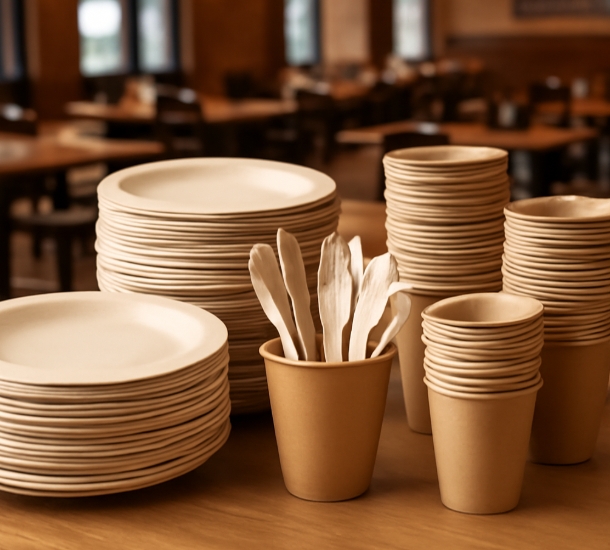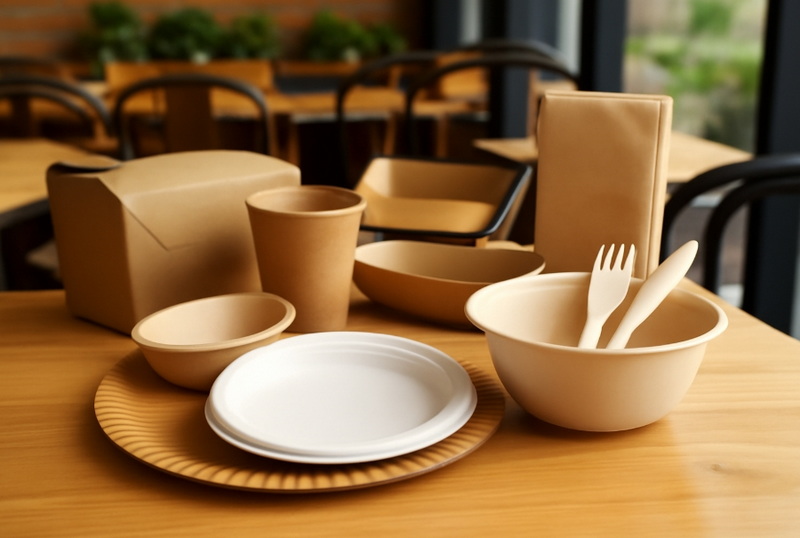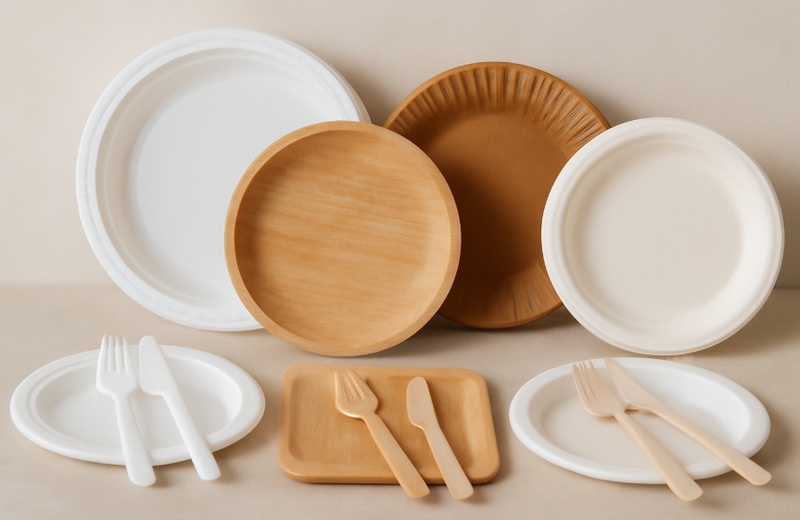
Content Menu
● Market Overview
>> Growth of Disposable Cutlery in Italy
>> Market Size and Segmentation
>> Regulatory Environment
● Key Trends in Disposable Cutlery
>> Sustainability
>> Customization and Branding
>> Innovation in Product Design
>> Circular Economy Initiatives
● Leading Disposable Cutlery Manufacturers and Suppliers in Italy
>> DOpla SpA
>> ILIP SRL
>> Huhtamaki SPA
>> IMB SPA
>> Fabbrica Pinze Schio SRL (ECOZEMA)
>> PIERROT
● Sustainability and Innovation in Italian Disposable Cutlery
>> Environmental Regulations and Industry Response
>> Product Development and Customization
>> Circular Economy and Local Expertise
● OEM and ODM Services for International Brands
>> Custom Product Development
>> Branding and Packaging
>> Quality Assurance
>> Flexible Logistics
>> The Role of Chinese Manufacturers
● Production Materials and Processes
>> Main Materials Used
>> Manufacturing Processes
>> Applications and End-Use
● Conclusion
● Frequently Asked Questions
>> 1. What are the main materials used by disposable cutlery manufacturers and suppliers in Italy?
>> 2. How do Italian suppliers ensure the sustainability of their disposable cutlery products?
>> 3. Can international brands order customized disposable cutlery from Italian manufacturers?
>> 4. What certifications should buyers look for when choosing a disposable cutlery supplier?
>> 5. How is the Italian disposable cutlery market expected to evolve in the coming years?
The Italian market for disposable cutlery is undergoing a dynamic transformation, shaped by evolving consumer habits, stricter environmental regulations, and the rapid expansion of food service and delivery sectors. As sustainability and convenience become central priorities, both local and international manufacturers are innovating to offer eco-friendly, functional, and visually appealing disposable cutlery solutions. This article provides an in-depth look at the top disposable cutlery manufacturers and suppliers in Italy, their product offerings, and the major trends influencing the industry. It also explores the role of OEM and ODM services, the impact of EU legislation, and the future outlook for this vibrant market.

Market Overview
Growth of Disposable Cutlery in Italy
Italy's disposable cutlery market has experienced significant growth over the past decade. This surge is closely linked to the rise of urban living, the proliferation of food delivery platforms, and the increasing demand for convenience in both domestic and commercial food service. Italian consumers, renowned for their appreciation of style and quality, are driving demand for disposable cutlery that not only serves its functional purpose but also aligns with aesthetic and environmental values.
Market Size and Segmentation
The market is segmented into various categories based on material (plastic, wood, bamboo, bagasse, etc.), end-use (household, commercial, events), and distribution channels (retail, wholesale, online). The commercial sector—including restaurants, caterers, and hotels—accounts for the largest share, while the retail segment is growing due to the popularity of home events and outdoor gatherings.
Regulatory Environment
The European Union's directive on single-use plastics has had a profound impact on the Italian disposable cutlery market. Manufacturers have been compelled to transition from traditional plastics to biodegradable and compostable alternatives. This has spurred innovation and opened new opportunities for suppliers who can meet the stringent requirements of both regulators and environmentally conscious consumers.
Key Trends in Disposable Cutlery
Sustainability
Sustainability is the defining trend in the Italian disposable cutlery industry. The shift away from petroleum-based plastics toward renewable, biodegradable, and compostable materials is now a market imperative. Italian manufacturers are at the forefront of this movement, investing in research and development to create products that minimize environmental impact without compromising on quality or functionality.
Customization and Branding
With competition intensifying, brands and wholesalers are seeking ways to differentiate themselves. Customization—through unique designs, colors, and digital printing—has become a key strategy. Disposable cutlery that features company logos or event-specific motifs is increasingly popular, especially among hospitality businesses and event organizers.
Innovation in Product Design
Italian manufacturers are renowned for their attention to design and detail. This extends to disposable cutlery, where innovation includes ergonomic shapes, heat-resistant materials, and multi-functional utensils. The goal is to enhance user experience while maintaining the convenience and disposability that consumers expect.
Circular Economy Initiatives
The concept of the circular economy is gaining traction in Italy. Manufacturers are exploring ways to ensure that disposable cutlery products can be recycled, composted, or used for energy recovery after their initial use. This holistic approach not only reduces waste but also supports Italy's broader environmental objectives.
Leading Disposable Cutlery Manufacturers and Suppliers in Italy
Italy boasts a diverse array of disposable cutlery manufacturers and suppliers, ranging from established domestic brands to international players with local operations. Below are some of the most prominent names in the industry:
DOpla SpA
DOpla SpA is a market leader with a comprehensive range of disposable tableware, including cutlery. The company is committed to sustainability, offering products made from biodegradable and compostable materials. DOpla's investments in eco-friendly technology and compliance with EU regulations have positioned it as a preferred supplier for both domestic and international clients.
ILIP SRL
ILIP SRL specializes in innovative food packaging and disposable cutlery. Their portfolio includes both traditional plastic options and new, sustainable alternatives. ILIP's products are widely used in catering, retail, and food service sectors, and the company is known for its focus on design, functionality, and environmental responsibility.
Huhtamaki SPA
As part of the global Huhtamaki Group, Huhtamaki SPA is a pioneer in sustainable packaging. The company offers flexible and recyclable disposable cutlery solutions, serving both local and export markets. Their commitment to quality and innovation has earned them a strong reputation among food service providers and retailers.
IMB SPA
IMB SPA manufactures a broad range of disposable tableware, including eco-friendly cutlery. The company places a strong emphasis on quality control, safety, and compliance with European standards. IMB's products are popular among hotels, restaurants, and catering companies seeking reliable and sustainable solutions.
Fabbrica Pinze Schio SRL (ECOZEMA)
ECOZEMA, a brand of Fabbrica Pinze Schio SRL, is renowned for its compostable and biodegradable cutlery made from plant-based materials. ECOZEMA is a preferred supplier for environmentally conscious brands and events, offering products that combine sustainability with Italian design flair.
PIERROT
PIERROT is a leading Italian producer and distributor of disposable table decoration products, including cutlery. The company offers a wide variety of materials, colors, and designs to meet the needs of the hospitality sector. PIERROT is also the exclusive distributor for PAPSTAR in Italy, expanding its product range with high-quality German-engineered solutions.

Sustainability and Innovation in Italian Disposable Cutlery
Environmental Regulations and Industry Response
The EU's directive on single-use plastics has been a catalyst for innovation in Italy's disposable cutlery market. Manufacturers are now prioritizing the use of:
- Biodegradable Materials: Such as wood, bamboo, bagasse, and plant-based plastics.
- Compostable Products: Designed to break down naturally after use, reducing landfill waste.
- Recyclable Options: Including r-PET and cardboard for both cutlery and packaging.
Product Development and Customization
Italian manufacturers have responded to consumer demand for premium, visually appealing products by:
- Investing in advanced printing techniques and designer patterns.
- Offering customizable options for branding and marketing.
- Developing smart packaging solutions, such as QR code-enabled cutlery for enhanced customer engagement.
Circular Economy and Local Expertise
Companies like PIERROT are integrating circular economy principles, ensuring their products are recyclable, compostable, or suitable for energy recovery. Their use of innovative materials like Airlaid “ESSENZA”—made from unbleached pure virgin cellulose—demonstrates a commitment to ecological responsibility. These efforts not only align with regulatory requirements but also resonate with consumers who prioritize sustainability.
OEM and ODM Services for International Brands
Italy's disposable cutlery manufacturers are well-equipped to serve international brands, wholesalers, and producers through OEM (Original Equipment Manufacturer) and ODM (Original Design Manufacturer) services. These services include:
Custom Product Development
From concept to final product, Italian manufacturers offer end-to-end solutions, including prototyping, material selection, and mass production. This flexibility enables international clients to develop unique products tailored to their specific market needs.
Branding and Packaging
Customization extends to branding and packaging, with options for digital printing, logo application, and tailored packaging solutions. This is particularly valuable for brands seeking to enhance their market presence and create a memorable customer experience.
Quality Assurance
Italian suppliers adhere to rigorous quality assurance protocols, ensuring compliance with international food safety and environmental standards such as ISO, BSCI, SGS, FDA, and LFGB. This commitment to quality gives international buyers confidence in the safety and reliability of the products they source from Italy.
Flexible Logistics
Manufacturers offer a range of logistics options, including air, rail, and sea shipping, to meet diverse delivery timelines and budget constraints. This logistical flexibility is essential for global brands operating in fast-paced markets.
The Role of Chinese Manufacturers
While Italian companies are leaders in design and sustainability, Chinese manufacturers, such as Ancheng, play a significant role in supplying the global market. They offer competitive pricing, large-scale production capabilities, and a wide range of certifications for quality and sustainability. Many international brands source products from both Italian and Chinese suppliers to balance quality, cost, and supply chain resilience.
Production Materials and Processes
Main Materials Used
Italian disposable cutlery manufacturers and suppliers utilize a variety of materials to meet different market needs:
- Birch Wood: Sourced from sustainable forests, birch wood is prized for its strength, smooth finish, and eco-friendly profile. It is commonly used for premium disposable cutlery.
- Bamboo: Fast-growing and renewable, bamboo is an increasingly popular choice for biodegradable cutlery.
- Bagasse: A by-product of sugarcane processing, bagasse is used to make compostable spoons, forks, and knives.
- Plant-Based Plastics: Derived from renewable resources such as cornstarch, these plastics offer compostability and a reduced carbon footprint.
- Cardboard: Used for innovative fold-out spoons and other utensils, often with water-based coatings for food safety.
Manufacturing Processes
The production of disposable cutlery in Italy typically involves the following steps:
1. Material Sourcing: Raw materials are sourced from certified suppliers who adhere to sustainable forestry and agricultural practices.
2. Cutting and Shaping: Advanced machinery is used to cut, shape, and finish the utensils according to precise specifications.
3. Surface Treatment: Depending on the material, cutlery may undergo polishing, coating, or printing to enhance appearance and functionality.
4. Quality Control: Each batch is subjected to rigorous quality checks to ensure compliance with safety and performance standards.
5. Packaging: Finished products are packaged in eco-friendly materials, often with options for branding and customization.
Applications and End-Use
Disposable cutlery produced by Italian manufacturers serves a wide range of applications:
- Public Catering: Used in restaurants, cafes, and catering events.
- Outdoor Events: Ideal for picnics, weddings, banquets, and corporate gatherings.
- Retail and Wholesale: Sold in supermarkets, specialty stores, and online platforms for household use.
- Food Delivery and Takeaway: Essential for the booming food delivery sector, where convenience and hygiene are paramount.
Conclusion
Italy's disposable cutlery industry is a vibrant and innovative sector, shaped by a strong commitment to sustainability, design excellence, and customer service. Leading manufacturers such as DOpla SpA, ILIP SRL, Huhtamaki SPA, IMB SPA, Fabbrica Pinze Schio SRL (ECOZEMA), and PIERROT are setting new standards in product quality, environmental responsibility, and customization. As the market continues to evolve, driven by regulatory changes and shifting consumer preferences, Italian suppliers are well-positioned to meet the needs of both domestic and international clients.
For brands, wholesalers, and producers seeking reliable disposable cutlery manufacturers and suppliers, Italy offers a wealth of options characterized by innovation, flexibility, and a deep respect for the environment. Whether you are looking for eco-friendly materials, bespoke designs, or comprehensive OEM/ODM services, the Italian market delivers solutions that combine tradition with forward-thinking sustainability.

Frequently Asked Questions
1. What are the main materials used by disposable cutlery manufacturers and suppliers in Italy?
Italian manufacturers use a variety of materials, including biodegradable plastics, wood, bamboo, bagasse (sugarcane fiber), and recyclable cardboard. The choice depends on the intended use, regulatory requirements, and customer preferences.
2. How do Italian suppliers ensure the sustainability of their disposable cutlery products?
Suppliers focus on using renewable resources, adopting compostable and biodegradable materials, and complying with EU regulations on single-use plastics. Many also invest in R&D to create innovative, eco-friendly alternatives and participate in circular economy initiatives.
3. Can international brands order customized disposable cutlery from Italian manufacturers?
Yes, most leading Italian manufacturers offer OEM and ODM services, including custom product development, branding, and packaging solutions tailored to the needs of international brands, wholesalers, and producers.
4. What certifications should buyers look for when choosing a disposable cutlery supplier?
Key certifications include ISO (International Organization for Standardization), BSCI (Business Social Compliance Initiative), SGS (Société Générale de Surveillance), FDA (U.S. Food and Drug Administration), and LFGB (German Food, Articles of Daily Use and Feed Code).
5. How is the Italian disposable cutlery market expected to evolve in the coming years?
The market is expected to continue growing, with increased emphasis on sustainability, innovation, and premium product design. Manufacturers will likely expand their eco-friendly product lines, invest in advanced manufacturing technologies, and strengthen partnerships with international distributors.

















